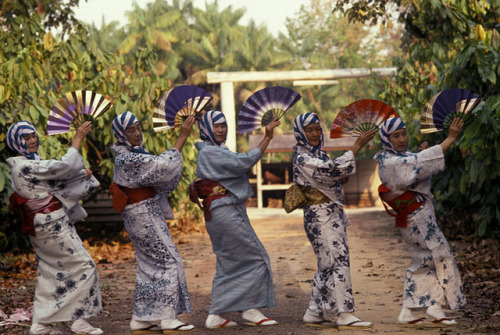#asian latinxs
Tomé Açu, Pará a Japanese colony in the Brazilian Amazon
“Tome-Acu is, fittingly perhaps, a hybrid of unlikely elements. On a given Sunday, worshippers may choose between the Catholic church, two Buddhist temples, and a host of evangelical churches. Japanese is still the lingua franca here, and even now negotiating Portuguese is a painful exercise for many residents. In restaurants, chopsticks, miso and tofu accompany black beans, manioc, and beef steak, the staples of Brazilian cuisine. Last June, while every Brazilian soul was glued to the television for the soccer World Cup, Tome-Acu was preoccupied with its annual baseball tournament, held at the harvest of the spice pepper crop. The centerpiece of town nightlife is the Karaoke, the Japanese sing-along, where patrons emboldened by whisky or sake belt out Sinatra ballads, Brazilian pop hits, and a wealth of Japanese torchsongs.
This town is the fruit of one of this century’s most remarkable diasporas, which scattered millions of Japanese across the globe in scant decades. Fleeing overcrowding and depression at first, and then the ruins of World War II, poor Japanese poured out of the cramped islands and set out for the empty frontiers of Asia and the New World. One wave of émigrés went to Korea, Taiwan and Manchuria. Several more hit Hawaii and the American mainland, until immigration authorities slammed the U.S. borders shut in 1924. Yet another washed up in South America, all the way to the Andean highlands and down to Brazil. Sao Paulo, with a million Japanese, now harbors the largest community outside the home country.
In September 1929, the steamer Montevideo Maru docked at Rio de Janeiro, jammed with Japanese immigrants. Most of the arrivals headed to Sao Paulo and Parana, but 43 families turned north, sailing all the way to Belem, where the Amazon river empties into the Atlantic. They went 130 miles inland, deep in the rainforest, and built farms, schools, homes and hospitals.
By all rights this community ought not exist. For more than a century, the eastern Amazon has been the target of ill-starred official colonization plans. The first was in 1875, not far from here, in the Zona Bragantina, where fifteen “colonies” were founded. The settlers were Italians and Germans, lured by land grants from Brazilian Emperor Dom Pedro II. But the distances from farms to the markets in Belem were considerable and the terrain severe. Worse, the Bragantina’s soils were acid when they were not sandy. By 1901, the 70,000 settlers dwindled to only 16,000. “Agricultural colonization by Brazilians in the Amazon left only melancholy memories,” writes historian Roberto Santos.
Recruited by a Tokyo colonization company, Nantaku, which beckoned colonists to a “second Paradise,” the Japanese found instead intractable jungle, distant markets, and endemic disease. But a core of immigrants stuck it out. They founded a pair of villages, Tome-Acu and Quatro Bocas, and began to negotiate a covenant with the new and strange land.”
Content:
http://aliciapatterson.org/stories/japanese-amazon-riddle-farming-tropics
Post link

